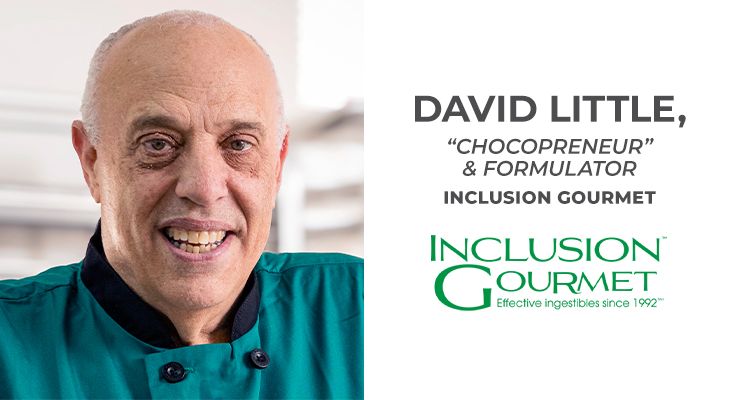Features
Insights in Eye Health
Growing the global market for eye health ingredients will require a clear vision for the future.

By: Sean Moloughney

Consumers at heightened risk for ocular diseases are focusing on prevention through proper nutrition and dietary supplementation, consequently driving global demand for proven, natural ingredients while also spurring competition, innovation and advanced research.
Eye health ranks fourth among top consumer health concerns in the U.S., and Nutrition Business Journal (NBJ), Boulder, CO, estimates sales for vision health supplements reached $233 million in 2007, up from $203 million the previous year.
Conversely, Europeans rank eye health ninth on their list of top health worries. However, according to a recent report from Frost & Sullivan, Europe seems primed to progress. The research firm valued the European market at $43 million in 2007-representing a growth rate of more than 6% over the previous year-and predicts revenues will rise 12% by 2014.
“The market has witnessed considerable growth, spurred by consumer health concerns of eye diseases, product innovations and the penetration of eye health ingredients into newer application segments, such as functional foods and beverages,” said Natasha Telles, research analyst, Frost & Sullivan.
Prevalence of eye diseases such as cataracts, glaucoma and age-related macular degeneration (AMD) has caused growing concern among consumers-aging populations in particular.
For example, cataracts affect more than 17% of Americans over the age of 40. Likewise, AMD has become the leading cause of legal blindness in the western world, said Ms. Telles. “Globally, this disease accounts for 25 to 30 million cases, and the figure is expected to triple over the next two decades.”
Facing such facts and forecasts, many Baby Boomers are incorporating protective nutrients into their diet and supplement regimens. “Prevention is a concept that is more at the forefront of eye care than ever, thanks to superior research and the willingness from more and more ophthalmologists to advise their patients about lifestyle choices that can affect vision and ocular health,” said Matt Philips, president, Cyvex Nutrition, Irvine, CA.
Prevention has become a more viable option in the face of costly, somewhat ineffective treatment options for eye diseases like AMD, said Phil Gowaski, sales and marketing manager, Chrysantis, West Chicago, IL. “In 2007, an article published in Ophthalmology estimated the cost to save a single line of vision through pharmacologic therapies for AMD to be $77 to $1248.” However, that could change, he added, as competition thrives among biotechnology companies intent on developing new drug therapies.
Citing NBJ estimates, Greg Berthomieu, business development manager, PharmLine, Florida, NY, noted that revenues for eye health prescription products reached almost $5 billion in 2007, representing 19% growth for the previous year. “This would mean that consumers and healthcare providers are more focused on treatments as opposed to prevention,” he said.
Still, consumers increasingly aware of age-related vision problems, alongside rising incidence of AMD and other ailments, has laid the foundation for a profitable eye health market within the nutraceuticals sector, said Ms. Telles.
And Baby Boomers aren’t the only ones at risk. “Preventive care needs to include all age groups,” she added. “Such a need is apparent due to the rise in exposure to ultraviolet (UV) rays. The adverse effects of such exposure and the rise in use of visual display units (VDUs) as a way of life have increased the incidence of eye fatigue (asthenopia).”
Charles DePrince, president, Fuji Health Science, Burlington, NJ, agreed that asthenopia has become “epidemic” over the past 10 years as a result of ubiquitous devices like computers, cell phones and iPods. “There is no question in my mind that this represents an opportunity for the dietary supplement industry to find a truly new growth area,” he said.
Diabetes and eye health are also converging health concerns, according to Scott Steinford, president, ZMC-USA, The Woodlands, TX. “People with diabetes are 20 times more likely to become blind than those without diabetes,” he said. “Diabetic retinopathy is the most common diabetic eye disease and a leading cause of blindness in American adults. It is caused by changes in the blood vessels of the retina. I have seen little marketing or education in terms of establishing a link of importance between diabetes and eye health, but the science clearly indicates a need.”
Frank Schonlau, PhD, director of scientific communications, Horphag Research/Natural Health Science, Geneva, Switzerland, agreed, saying that supplementation with established ingredients can arrest progression. “With the number of diabetes cases rising sharply, the incidence of diabetic retinopathy is expected to grow and represent a serious health concern within the coming years,” he said.
Eyes on Awareness
As with other nutraceutical markets, experts often point to consumer awareness as a key factor in advancing the eye health segment. The landmark Age-Related Eye Disease Study (AREDS) conducted in 2001 by the National Eye Institute (NEI) of the National Institutes of Health (NIH) has certainly offered consumers more insight into eye health benefits offered by antioxidant vitamins A, C and E in combination with copper and zinc.
Research indicates antioxidants help prevent photoreceptor loss caused by abnormal growth of blood vessels. “The mechanism of action for antioxidants in the protection against AMD and cataracts is their role in quenching free radicals in the retina and lens that lead to oxidative damage to the rod and cone cells in the retina and to opacity of the lens,” said James Elliott, PhD, director of nutritional science, DSM Nutritional Products, Parsippany, NJ.
The potential health impact offered from AREDS supplements is enormous, according to Sharrann Simmons, senior marketing manager, Cognis Nutrition & Health, LaGrange, IL. “Approximately eight million people are estimated to be at risk of developing advanced AMD. Should all these individuals take AREDS supplements, it is estimated that 300,000 could be saved from developing advanced AMD in the next five years.”
Vitamin A, for example, plays an essential role in image processing. Deficiency among women and children in developing countries has become a significant concern. “Vitamin A aldehyde (retinal) is part of the molecule rhodopsin and thereby participates in a signaling cascade that converts light into neuronal messages, and finally into ‘vision’,” said Ute Obermueller-Jevic, PhD, head of communication, BASF Nutrition Ingredients, Florham Park, NJ. “Insufficient vitamin A intake is a major health problem in developing countries where deficiencies cause night blindness, eye diseases and often total blindness (among other vitamin A-related diseases).”
Don Stanek, director of sales with Easton PA-based Linnea Inc., which has manufacturing facilities in Switzerland, sees a pressing need to inform the public about other eye health nutrients. “Most average consumers are not aware of the various nutritional supplements available for eye health and the prevention of vision problems,” he said. “More awareness through practitioners is needed along with the industry stressing good quality raw materials.”
PharmLine’s Mr. Berthomieu says consumer awareness is based on information people get from various origins. But basically,he said, “Solid scientific support is what has been driving consumer awareness in this category. A strong clinical study reported by the news media will push supplement manufacturers to develop new formulas and promote new ingredients, and will convince healthcare providers to prescribe new products.”
Ingredients Close-Up
Building on previous study findings, NEI has launched AREDS2, a multi-center, randomized clinical intervention study involving 4000 subjects, which is currently evaluating the potential impact of lutein, zeaxanthin and omega 3 fatty acids DHA and EPA on eye health.
Backed by clinical evidence supporting its ability to reduce the risk of eye diseases like cataracts and AMD, lutein has become a category standout. Consumer awareness for this potent carotenoid has reached nearly 34%, according to Cognis’ Ms. Simmons, a substantial uptick from just 3% a decade ago.
“In light of the compelling evidence for lutein, studies continue to show a dietary gap among Americans,” said Ms. Simmons. “Most adults do not consume the recommended daily servings of fruits and vegetables, so supplementation can help to bridge the gap. Also, the body does not produce lutein, another reason why supplementation is prudent.”
Leafy green vegetables like spinach and kale are important dietary sources of lutein, which is found in the so-called yellow spot of the eye-part of the macular region in the retina responsible for central vision.
Lutein is often taken in combination with zeaxanthin-another xanthophyll carotenoid. “In healthy eyes, the right level of lutein and zeaxanthin pigments is believed to play a role in filtering out more than 40% of potentially harmful blue light, thereby protecting the photoreceptors of the eye tissue,” said Abhijit Bhattacharya, COO, OmniActive Health Technologies, Short Hills, NJ. “Additionally, as powerful antioxidants with strong free-radical scavenging properties, lutein and zeaxanthin isomers present in these tissues are believed to reduce the impact of the photo-oxidative damage caused by blue light and age-related processes, and also prevent the formation of abnormal blood vessel growth.”
Awareness of zeaxanthin is still in its infancy stage, according to DSM’s Dr. Elliott. “However, science shows both lutein and zeaxanthin play an important and unique role in eye health and the combination of both is critical,” he said.
A recent study from the Vision Science Laboratory at the University of Georgia suggests that nutritional support for eye health should begin earlier than previously thought. Researchers found that young people who took zeaxanthin and lutein showed nearly 60% greater ability to detect targets through a veiling glare and demonstrated 15% faster recovery time from intense light.
Astaxanthin
Communication of health benefits validated by clinical research will continue to drive awareness for other ingredients like astaxanthin, experts say. Rudi Moerck, president and CEO, Valensa, Eustis, FL, said numerous studies have shown astaxanthin effectively addresses free radical and light-induced damage associated with visual impairment.
“With its ability to cross the blood-brain/blood-eye barriers and concentrate in the retinal macula, astaxanthin is now emerging as the preeminent alternative to lutein or zeaxanthin for eye healthcare supplementation in the management of eye-related oxidative stress and the mitigation of macular degeneration,” he said.
According to Fuji Health Science’s Mr. DePrince, over the past five years his company has sponsored nine human clinical studies at six different universities and technical institutes on the use of its AstaReal astaxanthin, demonstrating significant results for the reduction of asthenopia. “I see the use of astaxanthin for eye fatigue as a way for the dietary supplement industry to capture additional market potential without cannibalizing any existing business,” he said.
Omega 3s
Alongside a host of emerging and established health benefits, omega 3 fatty acids EPA and DHA have been recognized for their potential to reduce AMD risk, according to a meta-analysis published in the June 2008 edition of the Archives of Ophthalmology.
The report involved nine studies that included a total of 88,974 participants-3203 with AMD. Results showed that high EPA intake was associated with a 23% reduction in the risk of early AMD, whereas DHA was associated with a 30% reduction.
“EPA and DHA are necessary for visual development and protection of cell membranes,” said Chrysantis’ Mr. Gowaski. “The addition of omega 3 oils in combination with other eye health ingredients has also become popular.”
DHA plays an essential structural role in the membrane of the retina where it is found in high concentrations, said DSM’s Dr. Elliott. “Omega 3 fatty acids protect against the onset and progression of AMD by preventing the formation of new blood vessels in advanced AMD, reducing inflammation and protecting against cell death.”
Scientific evidence also suggests that DHA contributes to optimal visual development in infants, noted BASF’s Dr. Obermueller-Jevic. “Additionally, data from the Women’s Health Initiative indicate there is an association between intake of omega 3 fatty acids and a decreased incidence of dry eye syndrome in women, supposedly due to anti-inflammatory activities. However, study results have to be confirmed in clinical trials.”
Berries
While interest surrounding the health benefits of berries has grown across the nutraceuticals industry, many manufacturers and researchers are taking a closer look at the ability of fruits high in anthocyanins to support vision.
According to Linnea’s Mr. Stanek, bilberry helps strengthen arteries and veins due to its high anthocyanoside content. “Linnea’s Bilberry 25 promotes general capillary health and various eye disorders,” he said. “Bilberry is commonly used to assist in the relief of eye fatigue, particularly among those performing fine detailed work, and also supports night vision.” It has also been effective in treatment of vascular retinal disturbances, cataracts and diabetic glaucoma and myopia, he added.
Black currant has also emerged as a viable ingredient in vision-support formulas, according to Mr. Phillips from Cyvex. In Japan, he says scientists have reported positive results in several studies linking this berry with eye health.
A study published in Molecular Vision in 2008 showed that supplementation with Mirtogenol, a combination of Mirtoselect standardized bilberry extract and Pycnogenol French maritime pine bark extract, significantly lowered high intraocular pressure, which reduces the likelihood of developing glaucoma.
“Further research on Mirtogenol for intraocular pressure is currently in progress and new findings are expected to emerge shortly,” said Dr. Schonlau, of Horphag Research/Natural Health Science.
Blueberries also derive antioxidant properties from anthocyanins, which confer their blue color. According to Thomas Payne, industry specialist representing the U.S. Highbush Blueberry Council, while ongoing research could offer promising benefits, recent studies indicate anthocyanins effectively cross the blood-brain barrier. Research published in the Journal of Agricultural Food Chemistry showed that anthocyanins were detected in eye, liver and brain tissue after scientists fed blueberries to pigs-which are considered a suitable model of human digestive absorption-suggesting that these polyphenols can accumulate in tissue beyond the blood-brain barrier and may offer protective health benefits.




















